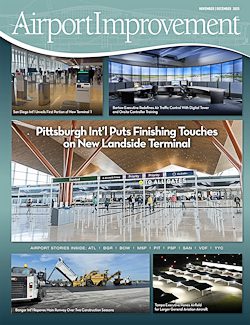After 24 years and more than 2 million miles in service, the people mover trains connecting the landside and airside terminals at Pittsburgh International Airport (PIT) are virtually all new and rolling into the future. A four-phase, $11 million project modernized the trains with new underframes and updated interior elements (flooring, air conditioning, lighting, etc.) Other upgrades include refurbished station doors, new digital signs on the loading/unloading platforms, and new mechanical and electrical components throughout the system.
The project began in October 2014 and ended in spring of 2016. Before it, the last significant renovation of the trains occurred in 1999. Operations personnel estimate that the trains have traveled more than 1 million miles carrying passengers and employees since then.
PIT officials characterize the massive renewal effort as a cost-effective way to bring the people mover system into the modern era and to complement other recent changes at the airport. Within the last few years, PIT has renovated baggage claim areas, upgraded concessions, improved new landside seating and installed new terrazzo flooring (see our May/June 2016, issue for more details). Amid the changes, the airport has experienced a 30% increase in nonstop destinations and an associated uptick in passenger traffic.
|
FACTS&FIGURES |
Millennial System
Placed into service in 1992, PIT’s $14 million people mover system logged more than 600,000 miles before it was updated and expanded in 1999. Driverless, rubber-tired trains run on two parallel tunnels below airfield taxiways, spanning the one-half mile between PIT’s landside and airside terminals. Largely a computer-operated system, the trains run with minimal human control except during unusual circumstances and emergencies.
Departing travelers board the underground people mover after passing through the TSA checkpoint and then proceed to their gates in the airside terminal.
Typically, each one-way trip takes less than two minutes: 70 seconds of travel along the automated guideway and a 30-second stop to load and unload. Efficiently designed stations allow each people mover to handle about 6,000 riders per hour. When the vehicle stops at the station, doors first open on the outer sides to allow passengers to exit. After those doors close, doors on the inner side (between the two tunnels) open to allow passengers to enter. Round windows at each end of the tunnels give riders a view of the entire journey.
Like the airport itself, PIT’s people mover system was designed and built to allow for expansion. In 1999, the airport closed the people movers one tunnel at a time so crews could demolish temporary walls and extend the passenger loading areas. One car was added to each train at a cost of $5.3 million, and the system’s original four cars were updated to the tune of $1.6 million. FROM that point forward each train had three cars.
Potentially, the people mover can be extended to service a second airside terminal if the airport expands in that manner. When PIT was originally designed, provisions were made so a second airside terminal could be placed beyond the current “X” shaped airside terminal to create more of a “Y” shape.
Currently, PIT serves more than 8 million passengers per year and ranks as the second busiest passenger airport in Pennsylvania, behind Philadelphia International.

Maintaining Service Standards
During the latest people mover renovations, the airport temporarily took train cars out of service. Crews lifted cars from the parallel tunnels with cranes through a ground-level hatch, and then Bombardier refurbished them at its nearby facility in West Mifflin, PA.

“The removal and return to service of two train cars at a time required considerable airport staff coordination to minimize impacts to the traveling public and airport employees,” notes Mike Adams, project manager for the airport authority. To offset slightly longer wait times for trains during renovations, PIT provided shuttle bus service to and from the airside terminal. It also added signs in key spots to facilitate passenger flow.
Throughout construction and renovations, it was important for the airport to maintain high levels of customer service, notes Christina Cassotis, chief executive officer of the Allegheny County Airport Authority. “Customer service is one of our strategic priorities,” she emphasizes. “This is just one of many upgrades underway at Pittsburgh International Airport to improve the customer experience.”


